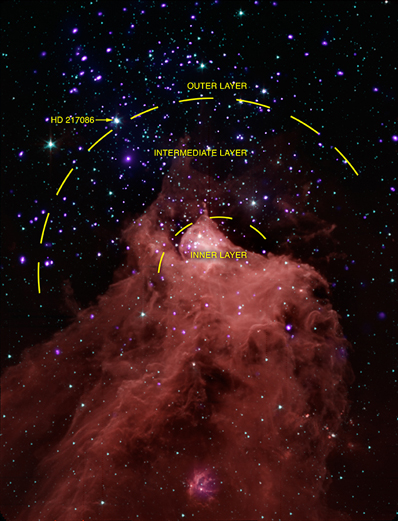


|

|
 |
|
Trigger-happy star formation KEITH COOPER ASTRONOMY NOW Posted: August 13, 2009 Star formation has often been blamed on gas clouds cooling sufficiently for gravity to overcome them and cause them to collapse, or perhaps on the shock waves of supernovae smashing into interstellar gas and forcing it to condense and collapse. Now, NASA’s Chandra and Spitzer space observatories have proven the existence of a third way. The two orbiting telescopes, operating at X-ray and infrared wavelengths respectively, turned their attention to a large star-forming region called Cepheus B, which is about 2,400 light years away. Cepheus B is illuminated by a huge star 20 times more massive than our Sun – called HD 217086 – and the star-forming cloud of molecular hydrogen contains hundreds of newborn stars. Young stars spin quickly, strengthening their internal dynamo so that they have stronger magnetic fields and hence produce stronger X-ray emission detectable by Chandra (see our related news story here). Meanwhile, Spitzer was able to seek out dust discs around young stars where planets are being formed. Together, they were able to judge where the youngest stars were.  A composite X-ray/infrared picture of the Cepheus B nebula and the compression wave riding through the gas cloud. X-ray image: NASA/CXC/PSU/K Getman et al; Infrared image: NASA/JPL–Caltech/CfA/J Wang et al.
A composite X-ray/infrared picture of the Cepheus B nebula and the compression wave riding through the gas cloud. X-ray image: NASA/CXC/PSU/K Getman et al; Infrared image: NASA/JPL–Caltech/CfA/J Wang et al.What they saw was that slightly older stars were present along the outskirts of the cloud, while the youngest stars were bunched up in an interstellar maternity ward at the centre of Cepheus B. This exactly matches what would be expected if the wave of star formation rippling through Cepheus B was triggered simply by the energetic stellar radiation wind emanating from the massive nearby star. This radiation drives a wave that runs through the gas, compressing it near the centre but at the same time evaporating, or ionising, the outer regions, where the older stars are found. “We essentially see a wave of star and planet formation that is rippling through this cloud,” says Eric Feigelson of Penn State University, who co-authored a paper about the research in the 10 July edition of The Astrophysical Journal. “We can even clock how quickly this wave is travelling, and it is going about 3,200 kilometres per hour,” adds Konstantin Getman, also of Penn State University, who led the research. “Astronomers had generally believed that it is somewhat rare for stars and planets to be triggered into formation by radiation from massive stars, [but] our new result shows that this belief is likely to be wrong.” It also has exciting implications about star formation in the early Universe. The population of massive stars in the Universe peaked around eleven billion years ago, and their radiation may have triggered the creation of vast amounts of smaller stars that we see in the Universe today. Since that time the production of massive stars has been on the wane, as has the overall numbers of stars being born in the Universe. It may be that triggered star formation had a much greater influence when the Universe was still relatively young. |
|
|
|
|